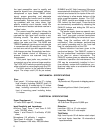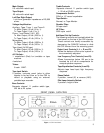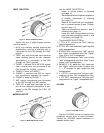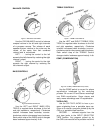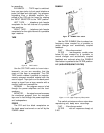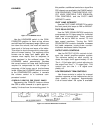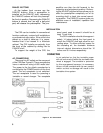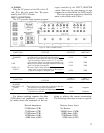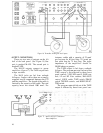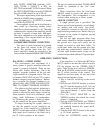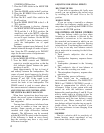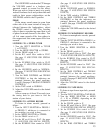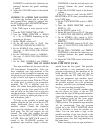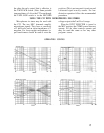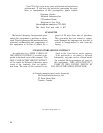COMPENSATED position.
7. Place the TAPE switch in the MONITOR
position.
8. Place the PHASE switch in the 0° position.
9. Place the RUMBLE filter switch in the
FLAT position.
10. Place the H.F. cutoff filter switch in the
FLAT position.
11. Turn the MODE SELECTOR to the L + R
TO L position.
12. While the program is playing, alternate
the MODE SELECTOR between the L + R
TO R and the L + R TO L position. On
amplifiers such as the MC225, adjust the
correct gain control until the loudspeak-
ers are of equal loudness. On the MC240
or the MC275, turn the balance control
until the loudspeakers are of equal
loudness.
The
stereo
system
is now
balanced.
It
will
remain balanced through all modes of opera-
tion. Leave the C22 extended on its PANLOC
stops for the next series of adjustments.
ADJUSTING PHASE
1. Set the MODE SELECTOR to STEREO.
2. Turn the BASS controls and TREBLE
controls to straight up position so that the
dial indicator centers between the panel
markings L and R.
Stand approximately 10 feet in front of
and midway between the loudspeakers. The
source of sound should appear to be directly
in front of you. Alternate the PHASE switch
between 0° and 180°. If the sound is not
directly in front of you in the 0° position,
reverse the leads to one loudspeaker. The
PHASE control is used to correct phase in
the source material whenever necessary.
ADJUSTING BALANCE CONTROL AFTER
THE SYSTEM HAS BEEN BALANCED
When these instructions have been com-
pleted, the overall system is balanced and in
phase; ready to deliver maximum pleasure
and enjoyment.
You may hear differences in balance from
one record to another or from one tape to
another. Some records or tapes may be
recorded with slight differences between
channels. The differences can be corrected
with the BALANCE control on the front panel.
If the difference is heard on every record,
then the cartridge may have a very small
difference in output.
ADJUSTING FOR SPECIAL EFFECTS
HF CUTOFF FILTER
If you wish to reproduce old, badly worn
records, you can minimize the surface noise
by switching the HF cutoff filter to the IN
position.
RUMBLE FILTER
If you are using a turntable or changer
which has low-frequency rumble noise, you
may reduce it by pushing the RUMBLE filter
switch to the FILTER position.
BASS CONTROLS AND TREBLE CONTROLS
The tone balance which you hear when
listening to an orchestra is affected by the
conductor's instructions to his musicians,
the acoustical environment in which you are
listening, and your own subjective hearing
interpretation. Considering these conditions,
it is easy to see why tone balance controls
play a major role in correcting for the follow-
ing factors:
1. Each person's subjective idea of tone
balance.
2. Loudspeaker frequency response charac-
teristics.
3. Loudspeaker placement in the listening
room.
4. The conductor's idea of tone balance at
the time the recording was made.
5. The microphone frequency response char-
acteristics.
6. The recording process influences.
These factors can be considered as
environmental influences. The BASS CON-
TROLS and TREBLE CONTROLS provide a
degree of compensation for effects of en-
vironment. Listen to your system with each
control set with the indicators centered
between the panel markings L and R. If you
wish to reduce treble in relation to bass for
example, turn the TREBLE CONTROLS coun-
terclockwise until the tone balance sounds
correct
to
you.
These
controls
will
modify
tone balance without introducing any unde-
sirable effects. Do not be surprised if you
find your preference in tone changing from
time to time.
LOUDNESS
Due to a selective shift in sensitivity of
human hearing, music reproduced at very
low volume loses its bass and treble.
12



